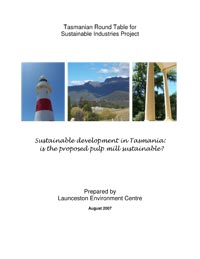As a result, the TRSIP commissioned a team of economists to study the economic claims made by the proponents and the impact the project will have upon the state’s economy. Tasmanian based Wells Economic Analysis and Melbourne based Economists at Large were chosen to conduct the study.
The TRSI study provides, for the first time, the entire picture - an assessment based on the costs, benefits and risks of the proposal.
In 2007 Economists at Large developed a financial model of the Gunns Bell Bay pulp mill and reported on our findings. We thought it was timely to put it on the website given Gunns has gone into administration. Our financial modelling showed that the Gunns Pulp Mill was highly sensitive to the exchange rate and pulp prices. The former going up and up to above parity with the USD in recent years and the latter going down. As a result of this our analysis indicated that the risks of the pulp mill were too great and the investment not worth it. Anyway, we’ll have to wait for the dust to settle on this one but here’s something from the recent and vindicated archives.
Key findings
- The proponents have made a simple but significant error by double counting the Pulp Mills tax benefit to the Tasmanian economy.
- A benefits analysis conducted by the proponents show an $834 million tax contribution over the life of the project but failed to show the $847.3 million in subsidies provided to the project.
- The proponents have only provided a benefits analysis to the Tasmanian economy. They have not factored in risks and costs.
- Only subsidies provided by the Australian taxpayer makes the mill profitable.
- Job gains during mill construction may well be offset by the “crowding out” of other development opportunities and job losses elsewhere.
- On a range of realistic scenarios, the Pulp Mill project may cause an economic loss to the State of Tasmania.
- The proposed pulp mill does not represent sustainable development for Tasmania.

